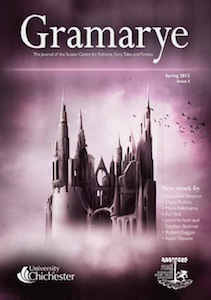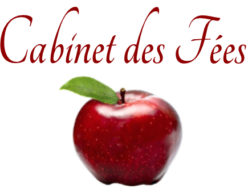 Gramarye
Gramarye
The Journal of the Sussex Centre for Folklore, Fairy Tales, and Fantasy
Issue 1, Spring 2012
Edited by Prof. William Gray, Dr. Jane Carroll, and Heather Robbins
Reviewed by Erzebet YellowBoy
Gramarye is the brand new Journal of the Sussex Centre for Folklore, Fairy Tales, and Fantasy, based at the University of Chichester in England. The inaugural issue appeared in Spring of 2012, and is the issue I’ll be reviewing here. It is 75 full-color pages printed on wonderfully thick paper, and includes illustrations by Brian Froud, Edmund Dulac, Warwick Goble, and more. Professor William Gray, who co-edits Gramarye with Dr. Jane Carroll and Heather Robbins, prefaces the journal with these words:
It is almost with a sense of wonder, and certainly one of delight, that I am writing the Preface to the first issue of Gramarye‘¦”
I would like to echo that sentiment and say I was delighted by what I found inside this journal. This could be in part because the first essay is called “Terry Pratchett: A Vast Consumer of Folklore”, by Jacqueline Simpson. My love affair with Discworld spans decades, something I apparently have in common with the author, who collaborated with Sir Pratchett on The Folklore of Discworld. The author discusses how that book came about with anecdotes about the book’s creation, and more importantly an explanation of why it happened in the first place. As if there weren’t enough reasons to admire Terry Pratchett, here we are given a glimpse of his determination to preserve rapidly vanishing folklore for future generations. Simpson’s story of the thought processes and research that went into The Folklore of Discworld is a must-read for any Pratchett fan.
Diane Purkiss, who readers might recognise as the author of ‘ªAt the Bottom of the Garden’¬: ‘ªA Dark History of Fairies, Hobgoblins, Nymphs, and Other Troublesome Things‘¬, writes about “The Undomestic Witch: Scottish Witches, Fairies and Old Religions”. Using the confessions, or dittays, of three historical Scottish witches (Andro Man, Marioun Grant, Issobel Gowdie), Purkiss discusses the beliefs of the undomestic witch: “a witch whose concerns and activities involve an exploration both spatial and intellectual of places outside the home and the hearth, the very places, in fact, that the home and the hearth exist to exclude.” The point of the article is to show how these beliefs developed from their beginnings in paganism through medieval Catholicism where they were, if not incorporated, at least in some fashion accepted, and then finally to the time of the trials, when religious Scotland was under the Protestant rule of the Kirk, and the beliefs were often executed with the believers. Purkiss makes no claims, but instead presents her cases clearly and with a wealth of information, and leaves us with much to think about.
The next piece in the journal is a short essay by Maria Nikolajeva, whose work in the field of children’s literature earned her the International Brothers Grimm Award for lifetime achievement. “My Favourite Story when I was young” is an unexpectedly deep piece that discusses why we should not hide the original, blood-thirsty tales from our children. Nikolajeva reveals that Hans Christian Anderson’s fairy tales “were perhaps the most formative in [her] childhood readings.” She was fortunate enough to have the complete, unabridged versions of his tales, which means she probably spent a lot of time hiding under her covers. Or did she? Nikolajeva says “all children would benefit from reading the original dark stories’¦,” but I won’t tell you which of those dark stories was her favorite — that would spoil it.
Two more pieces follow: Karl Bell writes about “The Legend of Spring-Heeled Jack: Urban Folklore and Victorian Popular Cultures” and John Herbert retells “Magic Fruit” from More Tales from Denmark, originally translated from the Danish by Stephen Badman. The issue closes with reviews of Anti-Tales: The Uses of Enchantment and New World Orders in Contemporary Children’s Literature: Utopian Transformations.
Overall, this is a wonderful start to a new production. With this first issue the editors have proven their commitment to respect the intersection of fantasy and folklore, and I am certain future issues will be every bit as informative and interesting as this one. If I have one criticism of the journal, it is in the choice of sans-serif font used for the body of the text. I’m getting on in years and my eyes aren’t what they used to be. A little bit of tracking, or letter-spacing, would go a long way. That’s just my opinion, and should not be seen as a flaw in this beautiful, colorful production. If I have one wish for the journal, it is that the editors consider that for those of us who love fairy tales, folklore, and fantasy, seventy-five pages is not enough.
Readers of CdF take note–the journal also includes submission information, which you can find online here, along with information on how to order a copy of your own.
